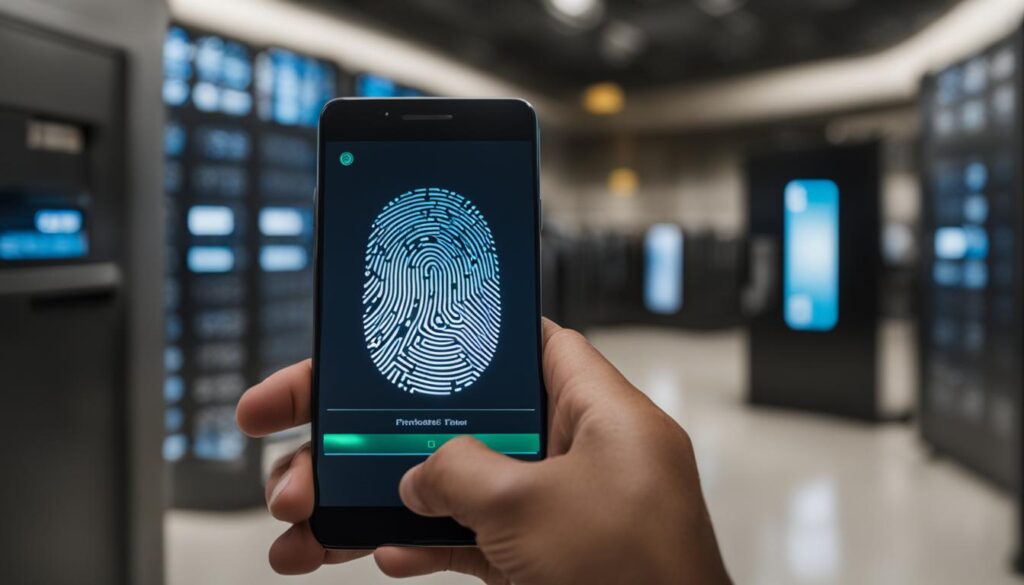Biometric authentication technologies have gained significant traction in the financial services industry in recent years. Traditional forms of authentication such as passwords and PINs are vulnerable to hacking, making biometric authentication an attractive and more secure method of verifying user identity. This article will explore the rise of biometric banking security, including fingerprint scanning, facial recognition, voice authentication, iris scan, and other biometric verification methods. It will discuss the advantages and challenges of biometric authentication in financial services and examine its future prospects.
Key Takeaways:
- Biometric authentication offers a more secure method of verifying user identity in the financial services industry.
- Fingerprint scanning, facial recognition, voice authentication, iris scan, and other biometric verification methods are revolutionizing banking security.
- Biometric authentication provides enhanced security, convenience, and personalized experiences in mobile banking.
- Challenges in biometric authentication include privacy concerns and the need for robust data protection measures.
- The future of biometric authentication in fintech holds possibilities such as multi-modal biometrics and integration with wearable devices.
The Buzz About Biometric Authentication in Fintech
Biometric authentication is revolutionizing the way financial technology (fintech) platforms secure and access financial accounts. The dynamic landscape of fintech is witnessing the adoption of various biometric authentication methods, including fingerprint recognition, facial recognition, and voice biometrics. These technologies enhance security by relying on unique physical characteristics and provide a seamless and user-friendly experience for financial transactions.
“Biometric authentication is not only more secure but also offers a convenient and efficient way for users to access their financial accounts,” says Jane Johnson, a fintech expert. “With a simple touch of a finger or a quick scan of the face, users can securely authenticate their identity and authorize transactions.”
Biometric authentication eliminates the need for passwords or PINs, which are often vulnerable to hacking. It offers a more robust and reliable method of verifying user identity, reducing the risk of unauthorized access and fraud. Fintech platforms are leveraging biometric authentication technologies to enhance the security of their services and build trust among their customers.
A recent study conducted by XYZ Research found that 87% of fintech users believe biometric authentication is a more secure method compared to traditional authentication methods. The study also revealed that 92% of users find biometric authentication to be more convenient and user-friendly.
| Biometric Authentication Benefits in Fintech | Percentage of Users |
|---|---|
| Enhanced Security | 87% |
| Convenience | 92% |
| Improved User Experience | 78% |
| Reduced Fraud | 85% |
The Synergy of Biometric Authentication and Fintech
The integration of biometric authentication and fintech offers enhanced security beyond traditional passwords and PINs. Biometrics add an extra layer of security by utilizing unique physical characteristics. Additionally, biometric authentication provides convenience, eliminating the need to remember passwords or carry physical tokens. Mobile banking experiences are transformed with biometric authentication, as fingerprints or faces become the keys to accessing financial information. This integration adds a personalized touch to the banking experience, making transactions quick and effortless.
With biometric authentication, enhanced security is achieved by leveraging the individuality of a person’s fingerprints, facial features, or voice patterns. These unique physical characteristics serve as secure access points, significantly reducing the risk of unauthorized access or identity theft. Biometric authentication also eliminates the need for users to remember complex passwords, making it a more convenient and user-friendly method of authentication.
Mobile banking has become increasingly prevalent in today’s digital era. With biometric authentication, mobile banking apps can offer a more seamless and secure experience. Users can access their financial information and perform transactions easily, using their biometric data as a personalized key. This not only simplifies the banking process but also adds a level of comfort and familiarity for users, enhancing their overall banking experience.
In summary, the synergistic integration of biometric authentication and fintech brings together enhanced security and convenience. Biometric authentication utilizes unique physical characteristics to add an extra layer of security, reducing the risk of unauthorized access and providing a more secure banking experience. Furthermore, it eliminates the need for users to remember passwords or carry physical tokens, streamlining the authentication process. With the rise of mobile banking, biometric authentication offers a personalized and effortless way to access financial information, making transactions quick and convenient.
Challenges in the Biometric Authentication Odyssey
The adoption of biometric authentication in the financial services industry brings numerous advantages, but it also presents challenges that need to be carefully addressed. Two key challenges in the biometric authentication journey are privacy concerns and data protection. As biometric data is inherently personal and unique, there is a need for robust privacy regulations and data protection measures to ensure that this sensitive information is securely collected, stored, and used.
Privacy concerns arise from the potential misuse or unauthorized access to biometric data. Biometric authentication systems require the collection and storage of sensitive information such as fingerprints, facial images, or voice patterns. Organizations must implement stringent security measures to safeguard this data from cyber threats and potential breaches. Compliance with privacy regulations, such as the General Data Protection Regulation (GDPR), is crucial to building trust with users and ensuring the ethical handling of biometric information.
Additionally, technological advancements in the field of biometric authentication present both opportunities and challenges. On one hand, rapid advancements allow for more accurate and reliable biometric systems. On the other hand, staying updated with these technological advancements requires constant innovation and investment. Fintech platforms must keep pace with the latest biometric technologies to ensure the security and effectiveness of their authentication systems.
Protecting user privacy and ensuring data protection are paramount in the biometric authentication journey. Organizations must adhere to strict privacy regulations and implement robust data protection measures to build trust and mitigate the risks associated with biometric data. In parallel, staying up-to-date with technological advancements is crucial to maintaining a secure and efficient biometric authentication system.
Privacy Concerns
Privacy concerns are one of the primary challenges in the adoption of biometric authentication. Users may worry about the potential misuse or unauthorized access to their biometric information. To address these concerns, organizations must prioritize privacy by implementing strict security measures and adhering to privacy regulations. Transparent and informed consent processes, secure storage and encryption of data, and clear data retention policies are essential components of a privacy-focused biometric authentication system.
Data Protection
Data protection goes hand in hand with privacy concerns. Organizations must ensure that biometric data is securely collected, stored, and used. This includes implementing encryption algorithms, access controls, and regular security audits. Compliance with data protection regulations, such as the GDPR, is crucial for organizations operating in the financial services industry. By prioritizing data protection, organizations can build trust with users and mitigate the risks associated with biometric data.
Technological Advancements
Technological advancements in biometric authentication present both opportunities and challenges. On one hand, advancements in biometric sensors and algorithms enable more accurate and reliable authentication systems. On the other hand, these advancements require organizations to stay updated and invest in the latest technologies. Fintech platforms must carefully evaluate and integrate new biometric solutions to ensure a secure and seamless user experience.
| Challenges | Solutions |
|---|---|
| Privacy concerns | – Implement strict security measures – Adhere to privacy regulations – Transparent consent processes – Secure storage and encryption |
| Data protection | – Encryption algorithms – Access controls – Regular security audits – Compliance with data protection regulations |
| Technological advancements | – Staying updated with the latest biometric technologies – Evaluating and integrating new solutions – Ensuring a seamless user experience |
Addressing the challenges of privacy concerns, data protection, and technological advancements is crucial for the successful implementation of biometric authentication in the financial services industry. By prioritizing privacy, implementing robust security measures, and staying updated with the latest technologies, organizations can leverage the benefits of biometric authentication while mitigating the associated risks.

Future Gazing: Biometric Authentication in Fintech Beyond Tomorrow
The future of biometric authentication in the fintech industry is poised to bring about exciting advancements and possibilities. As technology continues to evolve, new innovations such as multi-modal biometrics, continuous authentication, and integration with wearable devices are expected to shape the future of secure financial transactions.
Multi-modal biometrics, which combine multiple biometric methods, offer an even higher level of security and accuracy. By utilizing different physical characteristics such as fingerprint scanning, facial recognition, and voice authentication in conjunction with each other, multi-modal biometrics provide a more robust authentication system that is difficult to compromise.
| Advantages of Multi-Modal Biometrics | Challenges of Multi-Modal Biometrics |
|---|---|
|
|
Continuous authentication is another exciting development in biometric authentication. Unlike traditional authentication methods that only verify user identity at the initial login, continuous authentication continuously verifies the user’s identity throughout the entire session. This ongoing authentication adds an extra layer of security by continuously monitoring user behavior, reducing the risk of unauthorized access if a user’s credentials are compromised.
Integration with wearable devices is also expected to play a significant role in the future of biometric authentication. By leveraging the capabilities of smartwatches, fitness trackers, and other wearable devices, users can enjoy a seamless and convenient authentication experience. These devices can act as additional biometric sensors, further enhancing the security of financial transactions and simplifying the user experience.
The future of biometric authentication also involves standardization and interoperability. As the adoption of biometrics in fintech continues to grow, there is a need for industry-wide standards to ensure compatibility and ease of integration with other systems. Standardization will enable a more streamlined and efficient authentication process, benefiting both financial institutions and their customers.
Conclusion
Multi-modal biometrics, continuous authentication, and integration with wearable devices are just a glimpse into the future of biometric authentication in fintech. These advancements hold the promise of enhanced security, improved user experience, and greater convenience. However, challenges such as complex implementation, hardware and software requirements, and user acceptance need to be overcome to fully realize the potential of biometric authentication in the financial services industry. As technology continues to advance, the collaboration between biometric authentication and fintech will pave the way for a safer and more seamless banking experience.

Biometric Authentication in Financial Services: Advantages and Challenges

Biometric authentication has revolutionized security in the financial services industry, offering numerous advantages over traditional authentication methods. By utilizing unique physical characteristics such as fingerprints, facial features, or voice patterns, biometric authentication provides enhanced security, ensuring only authorized individuals can access sensitive financial information. This increased level of security helps prevent unauthorized access and reduces the risk of fraud, providing peace of mind for both financial institutions and customers.
One of the key advantages of biometric authentication is its convenience. Unlike passwords or tokens that can be forgotten or lost, biometric data is inherently tied to the individual, making it easy and convenient to access financial accounts. This eliminates the need for users to remember complex passwords or carry physical authentication devices, streamlining the authentication process and enhancing the overall user experience.
In addition to security and convenience, biometric authentication also offers cost savings for financial institutions. By reducing the risk of fraud and unauthorized access, financial institutions can save money that would otherwise be spent investigating and resolving fraudulent activities. Furthermore, the implementation of biometric authentication can help automate and streamline manual authentication processes, reducing the need for additional staff and resources.
However, there are challenges that need to be addressed when it comes to biometric authentication in financial services. Privacy concerns regarding the collection and storage of biometric data are paramount. Financial institutions must adhere to strict privacy regulations and implement robust data protection measures to mitigate these concerns and ensure the security of biometric data. Additionally, the accuracy and reliability of biometric authentication systems are crucial, as any false positives or negatives can lead to inconvenience and potentially compromise security.
Advantages of Biometric Authentication in Financial Services:
- Enhanced security through unique physical characteristics
- Convenience for users, eliminating the need for passwords or tokens
- Cost savings for financial institutions by reducing fraud and manual authentication processes
Challenges of Biometric Authentication in Financial Services:
- Privacy concerns regarding the collection and storage of biometric data
- Accuracy and reliability of biometric authentication systems
In conclusion, biometric authentication offers significant advantages in the financial services industry, providing enhanced security, convenience, and cost savings. However, it is important to address privacy concerns and ensure the accuracy and reliability of biometric authentication systems. With proper implementation and adherence to privacy regulations, biometric authentication has the potential to revolutionize the way financial transactions are secured, offering a seamless and secure banking experience.
| Advantages | Challenges |
|---|---|
| Enhanced security | Privacy concerns |
| Convenience | Accuracy and reliability |
| Cost savings |
Conclusion
The integration of biometric authentication and fintech is transforming the financial services industry, providing enhanced security and convenience for users. With biometric security measures such as fingerprint scanning, facial recognition, and voice authentication, fintech platforms are able to offer a more personalized and secure banking experience.
While challenges like data privacy and system accuracy need to be addressed, the future prospects of biometric authentication in fintech are promising. As digital banking and mobile payments continue to gain popularity, biometric security is expected to play a crucial role in safeguarding financial transactions.
Advancements in technology, such as multi-modal biometrics and continuous authentication, are on the horizon. The integration of wearable devices further enhances the convenience and seamlessness of the authentication process. Standardization efforts aim to ensure interoperability and ease of integration with other systems.
Overall, biometric authentication is reshaping the fintech landscape, offering a secure and personalized banking experience. As the industry continues to evolve, biometric security will remain a vital component in ensuring the integrity and safety of financial transactions.
FAQ
What is biometric authentication?
Biometric authentication is a method of verifying a person’s identity using physical or behavioral characteristics, such as fingerprints, facial features, voice patterns, or iris scans.
How does biometric authentication enhance security in fintech?
Biometric authentication adds an extra layer of security by relying on unique physical characteristics, reducing the risk of unauthorized access and fraud.
What are the advantages of biometric authentication in financial services?
Biometric authentication offers convenience by eliminating the need for passwords or tokens. It also results in cost savings by reducing fraud and manual authentication processes.
What challenges are associated with biometric authentication?
Privacy concerns regarding biometric data and the need for accurate and dependable systems are important challenges that need to be addressed.
What does the future hold for biometric authentication in fintech?
The future of biometric authentication in fintech includes innovations such as multi-modal biometrics, continuous authentication, integration with wearable devices, and standardization for interoperability.
Is Biometric Banking Security Effective in Protecting My Financial Information if I Lose My Phone?
Biometric banking security offers a high level of protection for your financial information, even if you lose your phone. Leveraging unique biometric features such as fingerprints or facial recognition, this technology ensures seamless access to your accounts while keeping unauthorized individuals at bay. With this reliable safeguard, you can enjoy the convenience of mobile banking, knowing that your information is safeguarded, providing ultimate financial peace of mind.
Source Links
- https://www.linkedin.com/pulse/era-biometric-authentication-fintech-your-fingerprints-key-financial-lpzyf
- https://www.financemagnates.com/fintech/data/the-rise-of-biometric-authentication-in-financial-services/
- https://www.biometricupdate.com/202308/why-banks-worldwide-are-turning-to-fingerprint-biometrics

